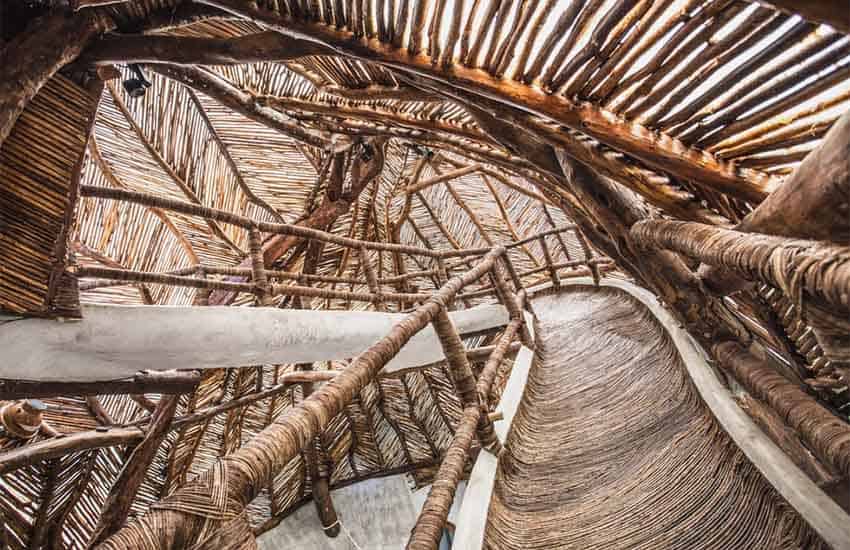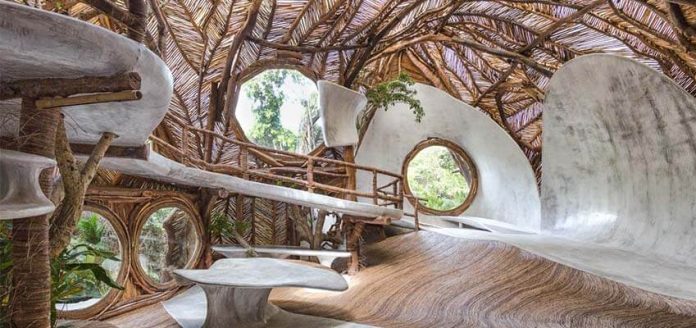Written about in the Financial Times, Vogue, Travel and Leisure and countless other media outlets, the Azulik Tulum hotel and its new art museum SFER IK have been called “boundary pushing” and an “international melee of creativity.” SFER IK’s creator himself is quoted as saying everything in the museum is “sustained by magic.”
The Instagrammable biophilic design has caught the attention of artists and influencers around the world who are now making the trek out to a previously unknown village 40 minutes west of Tulum for a glance at what some consider Mexico’s hottest new cultural attraction.
But does it live up to the hype?
Entering through a birth canal-like tunnel lined with curved bejuco (liana) wood, you come upon a wild-looking bridge, dappled with sunlight and overlooking the towering white domes that peek their heads up above the tree line of the Maya jungle. The entrance of the SFER IK Museum at the end of the bridge is a massive circle of glass, pivoting open to reveal an expansive room, with polished walls that wrap and undulate around the room’s interior, the color of the sky before it rains.

Vining pothos plants hang from the ceiling, draping from the various trees that have been left to grow within the museum’s rooms, holes left in the ceiling for their treetops. Pools glisten below and ethereal music plays in the speakers throughout this jungle gallery.
It’s truly stunning until you have to take your shoes off.
Then the idyllic setting transforms into a test of tolerance for sheer pain and you wonder if the architect might have a masochistic streak. Built in 2018, SFER IK was imagined as a space that would force people “to feel and play in the space before interacting with art,” I was told by Fernanda Ordaz, one of the project’s coordinators via email, “a different way of approaching the aesthetic experience, one that feels more connected because is more natural.”
I’m not sure how natural it felt to gouge my feet on the knotted and shellacked rope net above a drop of about five meters or to have my soles pinched ever so painfully as I walked across the wood slate bridge connecting one area of the museum with another. But after 45 minutes of walking across a floor made of bujeco vines, my feet felt like I had walked a pilgrimage barefoot for some promise made to the Virgin. I thought I went for art, but maybe I went for penance.
The museum is the brainchild of Eduardo Neira Sterkel, better known as “Roth,” who also designed and built Tulum’s Azulik hotel – another incredibly beautiful space with mixed reviews from its guests. Roth was out of town when I visited, and so apparently was anyone else with basic knowledge of the project since my guide, who had only been on site for two months, could answer very few of my questions.
In what has been called by some the “Mayan Guggenheim,” there are two current displays. MEXX by Japanese flower artist Azuma Makoto is an eight-meter giant sculpted from vines, concrete, fiberglass and living plants that attempts to observe how living art can integrate itself into the surrounding environment over time. My guide pointed to a few of the pothos plants that were draped over the sculpture as an expression of that integration, but when I asked if they had been placed there by the museum or had grown there naturally, she demurred.
The other piece was Every Tree is a Civilising Entity by Brazilian visual artist Ernesto Neto, a combination of woven fibers, stones and other natural materials that hovers over the room like a forest canopy from outer space. The piece is a continuation of what Neto has referred to as bringing “the voice of the forest” to the viewers of his work. This piece somehow felt perfectly suited for the upended indoor-outdoor narrative of the museum.
SFER IK has been hailed in many outlets as having no carbon footprint and being one with the surrounding nature, but there seemed to me some conspicuous incongruencies: while the area’s zapote trees were preserved during the building process and no machines were used in the construction, water was being continuously pumped into the museum’s dozens of low-lying pools, the pothos plants that decorated the walls and draped into the space are not endemic to the area and the tropical plants around the grounds were being watered by gardeners. When I probed a little further for ecofriendly aspects to the project – thinking I must have missed solar energy or water recycling or even composting – I was told just that the building materials used to make the structures were organic – an argument for concrete I’ve never heard before – and that they worked with the local Maya community on the construction.

This “City of Arts,” as it is called by its residents, includes four workshops where architects, designers and a few locals – although the percentage of that last group was not forthcoming from my guide – make pieces for the museum’s restaurant and grounds as well as the Tulum Azulik hotel. The beauty of those decorative pieces was undeniable – the intricate macrame wall hangings, or the one-of-a-kind ceramic pieces used in the restaurant, but access to the workshops is limited to the folks who work there and is not open to the public. My guide told me that there were no artist residences, but it was later confirmed that they do host artists three or four times a year.
The restaurant of the museum, Jungle Cuisine, is just as lovely as the museum itself, with small, bubbling pools, more draping vines and bossa nova covers of pop songs playing over the loudspeaker. The cuisine is supposedly based around traditional ingredients and regional cooking techniques, but I’ll never know since I was also told that I couldn’t eat there. Turns out that even if you have traveled over an hour and the 25-odd tables are empty — and especially if you are a lowly reporter — you’ll need a reservation.
When, hot and sweaty, I suggested that I might then just have a drink before heading back to Tulum in the midday broil, I was handed a bottle of water and scooted out the door.
On the way back into Francisco Uh May, the small town where the museum is located, I asked my motorcycle taxi driver what the locals thought of the museum. He said they were content – it had brought some jobs and raised the value of everyone’s land around it. But had he or anyone he knew ever been inside the museum? I asked, No, was the reply. As far as community involvement, Ordaz says there is an art school for community kids that happens once a week, but no one mentioned that during my visit.
Aesthetically speaking, the hype surrounding the SFER IK Museum is understandable; there is no denying that its beauty and its limited art collection is visually stunning. But if you go to SFER IK looking for something more – an institution that’s integrated into the local community, an exemplar of ecoconscious luxury or a bastion of bohemian hospitality – I’m afraid you might be disappointed.
Lydia Carey is a freelance writer and translator based out of Mexico City. She has been published widely both online and in print, writing about Mexico for over a decade. She lives a double life as a local tour guide and is the author of Mexico City Streets: La Roma. Follow her urban adventures on Instagram and see more of her work at www.mexicocitystreets.com.
